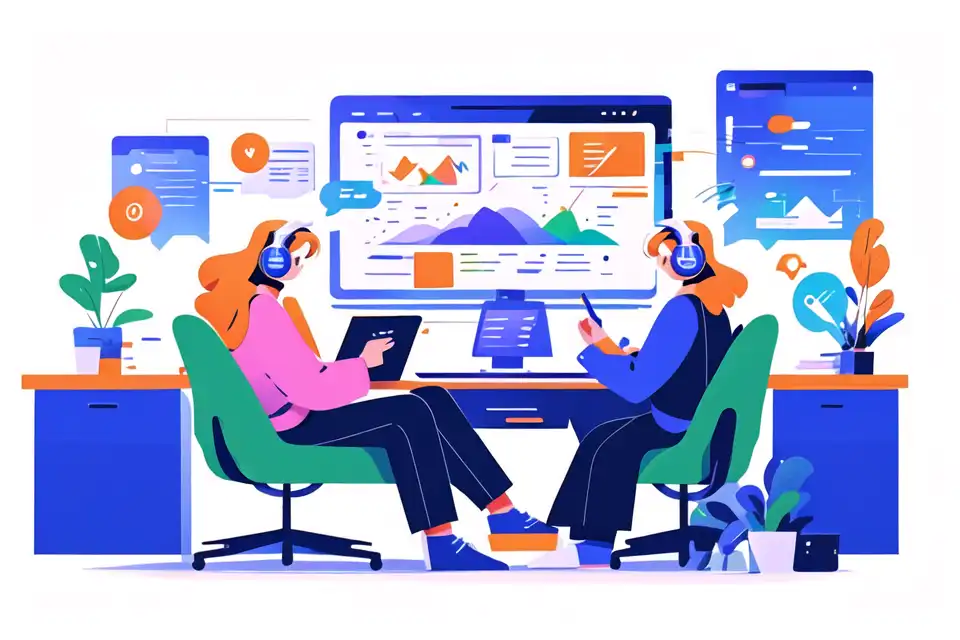Digital Teaching Tools
Learn about the top tips and strategies in digital teaching tools
Try Lark for Free
Overview of Digital Teaching Tools in the Educational Context
Digital teaching tools refer to software, applications, and platforms designed to enhance the overall teaching and learning experience. These tools span a wide range, from learning management systems (LMS) to interactive whiteboards, and even digital note-taking applications.
Importance of Digital Teaching Tools in Modern Learning Environments
The integration of digital teaching tools in classrooms is critical in the modern education environment. They foster interactive learning, promote student engagement, simplify complex concepts, and offer personalized learning experiences.
Interesting Trends and Statistics on Digital Teaching Tools
The digital teaching tools market is growing exponentially. According to a report by Grand View Research, the global digital education market size was valued at USD 8.4 billion in 2020 and is expected to grow at a compound annual growth rate (CAGR) of 19.9% from 2021 to 2028.
Unlock the power of Lark to elevate your business operations. Discover actionable strategies and best practices in our comprehensive guide.
Unraveling the benefits of digital teaching tools
Enhancing Teaching and Learning with Digital Tools
Digital teaching tools not only modernize classrooms but also enhance teaching methodologies. They facilitate better visualization of complex concepts, foster interactive learning, and provide instant feedback, thereby improving student performance.
Impact of Digital Teaching Tools on Student Engagement and Outcomes
Research shows that digital teaching tools significantly enhance student engagement. They make learning a more interactive and enjoyable process, leading to improved student outcomes.
Related:
Education Solution | LarkLearn more about Lark can help you with everything mentioned so far in the article.
Implementing digital teaching tools in education
Steps to Integrate Digital Teaching Tools into the Classroom or Curriculum
The implementation of digital teaching tools involves a series of steps, starting with identifying the appropriate tools, training educators, integrating the tools into the curriculum, and continuously monitoring their effectiveness.
Tools and Resources Needed for Efficient Use of Digital Teaching Tools
The efficient use of digital teaching tools requires resources such as reliable internet connectivity, digital devices, and a supportive IT infrastructure. Furthermore, teachers need adequate training to effectively use these tools.
Case studies and examples: success with digital teaching tools
Example 1: digital transformation in abc school
Example 1: digital transformation in abc school
ABC School integrated a variety of digital teaching tools into their curriculum, resulting in improved student engagement and performance. The school reported a significant increase in class participation and an overall improvement in grades.
Example 2: improved student engagement at xyz university
Example 2: improved student engagement at xyz university
XYZ University adopted a comprehensive digital learning management system, which allowed for interactive learning and seamless communication between students and teachers. The university reported improved student attendance and engagement.
Example 3: seamless online learning with lark in def institute
Example 3: seamless online learning with lark in def institute
DEF Institute adopted Lark, a comprehensive digital teaching tool that offers a wide range of functionalities. With Lark, DEF Institute was able to efficiently manage online classes, foster collaborative learning, and effectively monitor student progress.
Related:
Education Solution | LarkLearn more about Lark can help you with everything mentioned so far in the article.
Overcoming challenges in the adoption of digital teaching tools
Potential Obstacles when Adopting Digital Teaching Tools
Despite their numerous benefits, the adoption of digital teaching tools comes with its challenges, such as resistance from teachers, lack of technical skills, and insufficient IT support.
Strategies to Overcome These Challenges
Addressing these challenges requires a holistic approach, including providing adequate training to teachers, investing in IT infrastructure, and continuously evaluating the effectiveness of the tools.
The future of digital teaching tools in education
Emerging Trends Related to Digital Teaching Tools
The future of digital teaching tools is promising, with emerging trends such as Artificial Intelligence (AI), virtual reality (VR), and gamification shaping the educational landscape.
Predictions for How Digital Teaching Tools Will Shape Education
Digital teaching tools are expected to revolutionize education, making learning more personalized, interactive, and engaging. They will also bridge the gap between teachers and students, fostering a more collaborative learning environment.
Learn more about Lark can help you with everything mentioned so far in the article.
Tips for effective use of digital teaching tools
| Do's | Don'ts |
|---|---|
| Do keep up with the latest digital teaching tools. | Don't ignore the importance of training and familiarization. |
| Do utilize digital tools to enhance student engagement. | Don't rely solely on technology for teaching. |
| Do encourage student collaboration through digital platforms. | Don't overlook potential security concerns with digital tools. |
Learn more about Lark can help you with everything mentioned so far in the article.
Conclusion: embracing the digital future of education
In conclusion, digital teaching tools play a crucial role in transforming education, making it more interactive, personalized, and engaging. As we move towards a digital future, these tools will continue to revolutionize the educational landscape, fostering a more collaborative and effective learning environment.
Unlock the power of Lark to elevate your business operations. Discover actionable strategies and best practices in our comprehensive guide.








